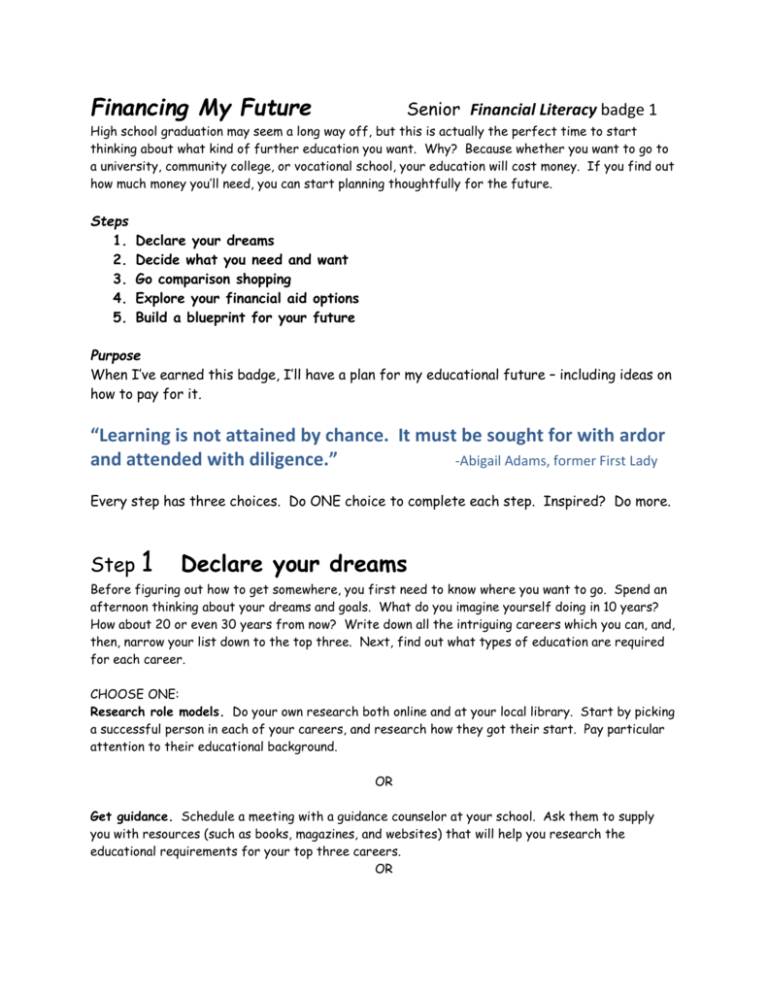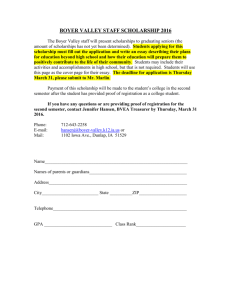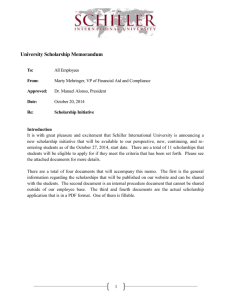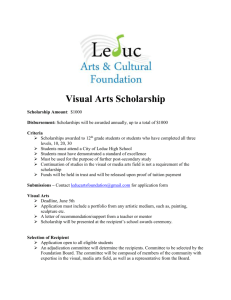Senior - Financing My Future
advertisement

Financing My Future Senior Financial Literacy badge 1 High school graduation may seem a long way off, but this is actually the perfect time to start thinking about what kind of further education you want. Why? Because whether you want to go to a university, community college, or vocational school, your education will cost money. If you find out how much money you’ll need, you can start planning thoughtfully for the future. Steps 1. 2. 3. 4. 5. Declare your dreams Decide what you need and want Go comparison shopping Explore your financial aid options Build a blueprint for your future Purpose When I’ve earned this badge, I’ll have a plan for my educational future – including ideas on how to pay for it. “Learning is not attained by chance. It must be sought for with ardor and attended with diligence.” -Abigail Adams, former First Lady Every step has three choices. Do ONE choice to complete each step. Inspired? Do more. Step 1 Declare your dreams Before figuring out how to get somewhere, you first need to know where you want to go. Spend an afternoon thinking about your dreams and goals. What do you imagine yourself doing in 10 years? How about 20 or even 30 years from now? Write down all the intriguing careers which you can, and, then, narrow your list down to the top three. Next, find out what types of education are required for each career. CHOOSE ONE: Research role models. Do your own research both online and at your local library. Start by picking a successful person in each of your careers, and research how they got their start. Pay particular attention to their educational background. OR Get guidance. Schedule a meeting with a guidance counselor at your school. Ask them to supply you with resources (such as books, magazines, and websites) that will help you research the educational requirements for your top three careers. OR Pool your knowledge. Team up with your friends to maximize your effort! Compile a group list of all the educational institutions and careers into which you want to look and divide it among you. Do research on your own, then, get back together to share your information. Create a group report that outlines everything you’ve learned. Step 2 Decide what you need and want There are lots of options when you’re considering higher education: the school’s location, the kind of programs it offers, what campus is like, and so on. Fill in the checklist (on the next page) to help guide your thoughts. CHOOSE ONE: Do this with a friend. Make a checklist on your own and talk with a friend to figure out what features are most important to you. OR Fill in your checklist with a family member or a Girl Scout adult. What advice can they give based on their experiences? When they chose a school or training program, what were some things that they thought would be important that turned out to not really matter? OR Set up a meeting with a guidance counselor to complete your checklist. To best use your time with the counselor, take the time to create a list of questions about your possible careers and higher-education options you might have. More to EXPLORE Ask other women. One way to create a great conversation is to invite young women currently attending a university or trade school to share their experiences with you. Ask them how they made their final decision, along with how they are paying for the education. Try to find women who represent a range of experiences that help them pay for their education: work-study job, off-campus job (related or not to her academic or career interests), loans or scholarships based on need or specific areas, ROTC, resident assistant, or other method. What type of school is best for you? DECISION CHECKLIST Check the features that are important to you. Then rate each checked feature from least important to most important in the boxes on the right. I want to live at home and go to a school nearby. I want to live near home, but in a dorm or my own apartment. I want to explore the world a bit - I'd like to go to school far away from home. I want to go to a small school. I want to go to a medium-size school. I want to go to a big school. If I go to school, it must have a beautiful campus. I want to go to a school with great career placement support. I want to go to a school with low faculty-to-student ratios and class sizes. I want to go to a school of which everyone's heard. I already know what subject I want to study, so I want to go to a school that's known for that. I want to go to a public school. I want to go to a private school. My education must be free. I want to go to a school where I can get a scholarship. Religion should play a part in the school I attend. Sports should play a part in the school I attend. Arts should play a part in the school I attend. I'd like to go to a school that allows me to still hang out with my from high school. The single most important consideration for me is: _________________________________________ Step 3 Go comparison shopping When shopping for jeans, you don’t just pick the first pair off the rack. You try on several pairs to find the perfect fit at the right price. Picking your educational path after high school follows the same principle. In this step, you’ll research three schools or training programs that interest you. Along with confirming that each is a good fit based on your future goals, you need to research the costs to see how they work with your budget. CHOOSE ONE: A great debate. After researching your educational picks, discuss them with two friends who know you well and aren’t afraid to ask you to justify your decisions. Spend at least 15 minutes analyzing the pros and cons of each option. Then, randomly pick the choices out of a hat, and hold a 20 minute debate in which each of your must defend your pick as the best. Remember, you don’t have to end up with a clear winner – having two or even three great choices is a good problem. OR Visualize your future. Start by gathering stacks of material for each choice, including brochures, website printouts, course guides, and even pictures of things like the campus or facilities. Use these materials to create a colorful poster for each choice. Hang up the posters and give a “tour” of each one to friends or family members, explaining in detail all the items on each poster, the cost per semester and financial aid options for each choice, and your thought about each one. Notice when you feel yourself becoming more enthusiastic – that could be a clue about which school is right for you! OR Circular logic. Spend at least an hour researching each of your three choices, including costs. Once you’ve got solid information on each one (like cost per semester, cost of books, room, and board), gather your Girl Scout friends in a circle. Explain your choices in detail, and, then, go around the circle and ask each girl to give a pro and con for each choice. After you’ve gone around the circle three times, open things up to a general discussion about everyone’s post-high school plans? Step 4 Explore your financial aid options It’s common to get some form of financial aid to pay for continuing education. This aid can come in the form of grants, student loans, or work-study programs. Or, it could be a scholarship, ranging from the dream of an all-expenses-paid “full-ride” to smaller but still very helpful scholarships that might pay for room and board or books. CHOOSE ONE: Find different types of aid. Go online to the U.S. Department of Education or to your high school guidance office and find out the different types of financial aid available to you. Make a list of the terms you learn about the types of financial aid that might work for you and your family. Find out the average amount of school loans for which you might qualify. OR Scholarship search. Earning great grades and being a top athlete are two of the best-known scholarship paths. Do some research, though, and you’ll be amazed at the array of other scholarship opportunities available. Using all resources available (your guidance counselor, library, the Internet, etc.) create a list of at least five scholarships for which you could apply in the years to come. OR Expert advice. Talk to a financial aid expert at a college or trade school. Set up an appointment – either in person or on the phone – to learn all you can about financial aid, requirements for different kinds of loans, application deadlines, and so on. Afterward, create a report that can be shared with friends. WACKY SCHOLARSHIPS There are all sorts of ways you can earn money to help fund your education – check out some of these examples! Chick and Sophie Major Memorial Duck Calling Contest: High school seniors compete for scholarships at a duck calling contest in Stuttgart, Arkansas. Stuck at Prom®: Earn money for school by making a prom outfit entirely out of duct tape. Make It With Wool: Students can win scholarships from the American Sheep Industry Association by making and modeling clothes made with wool or a wool blend. National Candy Technologists Scholarship: Interested in candy? This scholarship is awarded to students who would like to pursue a career in “confectionery technology.” Tall clubs International Scholarship: If you’re 5’10” or taller, an essay about “What Being Tall Means to Me” can win you this scholarship from Tall Clubs International. Many students take out federal loans to go to college. The first step in the process is filling out a Free Application for Federal Student Aid (FAFSA). With an adult’s help, take a look at this form to see what information is required. Step 5 Build a blueprint for your future Now it’s time to share your future educational goals by building a blueprint of your future. High school graduation may be a couple of years away, but you need to start laying the groundwork now. That might mean keeping a file of useful scholarships, earning better grades, or starting to save money. But, those are just examples! Make your own plan of what you need to do to get ready with one of these choices. CHOOSE ONE: Create a giant timeline. Using a large roll of paper, create a narrow poster that’s at least six feet long and tape it onto a free wall. Write down each month from now until your high school graduation along the poster. Start filling in the timeline with key dates and goals, ranging from months you’ll need to send in scholarship forms to personal goals, like raising your grade point average. OR Write an inspiring essay. Putting your dreams and goals down on paper is a good way to clarify them for yourself and give you a concrete goal for which to shoot. Write an essay about what you’d like to do with your life and what kind of education that will require. Get specific about the steps you need to take to get that education. Share your essay with friends and family, and ask for their advice and feedback. Remember, this essay is just one path you might take – you can change the route if your dreams change! However, simply having a possible future mapped out will help you reach your goal. OR Go to your guidance counselor. A guidance counselor’s job is to help students plan for the future, but it’s up to you to take full advantage of that. Create a list of 10 things you need to do each school year between now and high school graduation to meet your goals. Be sure to include at least two financial items per year. Then, review your lists with your guidance counselor for their feedback and support. Add the Badge to Your Journey Making a long-range plan and budget is a leadership skill! Use your new skill while planning a Take Action project. Now that I’ve earned this badge, I can give service by: Starting a “What’s Next?” club at school, where students can meet to discuss their post-high school plans Visiting with younger Girl Scouts to help them start making their future plans – including ways to pay for them Creating a comparison grid of schools in my local area to share with classmates I’m inspired to:






